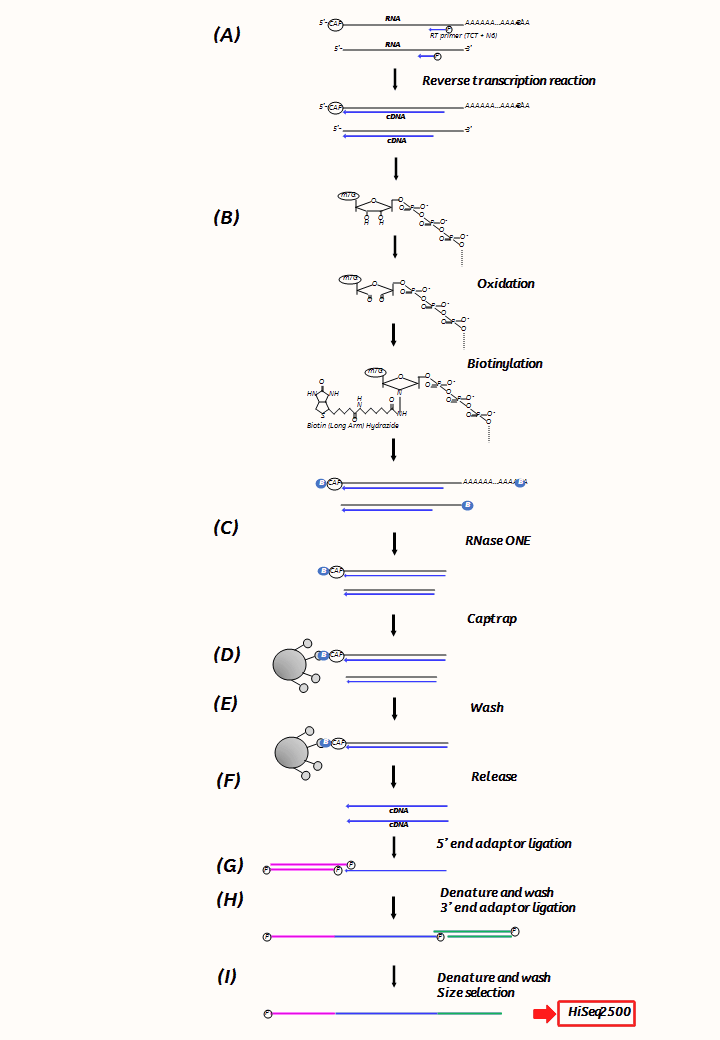In the past decade, Next Generation Sequencing technologies have been rapidly developed to reduce requirements of input sample amount and improve the accuracy and depth of sequencing reads['1']. The FANTOM consortium has been continuously optimizing and simplifying the Cap Analysis of Gene Expression (CAGE) technology['2'] ['3'], a method for genome-wide identification of Transcription Start Sites (TSS), to reduce technical biases and obtain high quality and high-cost performance datasets for various sequencing platforms.
The FANTOM5 consortium developed HeliScopeCAGE['4'], which generates reverse-transcribed cDNAs from capped RNAs without PCR amplification and sequences on the HeliScope Single Molecule Sequencer, and produced a large CAGE dataset from numerous types of mammalian cells. The consortium used the non-PCR-biased CAGE dataset and provided highly reproducible TSS annotations and a comprehensive overview of promoter expression['5'].
We further developed non-Amplified non-Tagging Illumina Cap Analysis of Gene Expression (nAnT-iCAGE)['6'] that was a modified version of HeliScopeCAGE for Illumina HiSeq2000/2500 sequencers.
Further technological improvements of the FANTOM6 project led to the development of single strand (ss)CAGE and low quantity (LQ)ssCAGE['7'] that create single stranded cDNA libraries without PCR. Here we show the workflow of the ssCAGE protocol (Figure).

Figure: ssCAGE protocol workflow
(A) Reverse transcription. cDNA is synthesized using SuperScript III and random N6 primer.
(B) Oxidation/Biotinylation. The cap structure is oxidized with sodium periodate (NaIO4) and biotinylated with biotin (long arm) hydrazine.
(C) RNase I digestion. Single strand RNA is digested with RNase I.
(D) Capture on magnetic streptavidin beads. Biotinylated RNA/cDNA hybrid molecules are captured using magnetic streptavidin beads.
(E) Wash unbound molecules. Unbound RNA/DNA hybrid molecules are washed away.
(F) Release ss-cDNA. Captured RNA/DNA hybrid molecules are released by heating, then treated with RNaseH and Rnase I.
(G) 5’-end adapter ligation. A universal 5’-end adapter is ligated to the ss-cDNA.
(H) 3’-end adapter ligation. After denaturing the dsDNA 5’-end adapter and washing away the unbound adaptors, a 3’-end adaptor containing an index sequence is ligated to the ss-cDNA.
(I) Size selection. After denaturing the dsDNA 3’-end adapter and washing away the unbound adaptors, a size selection purification is performed using SPRI beads to remove any adapter dimers. The library is then ready for sequencing on Illumina HiSeq2500.
Note: this protocol works well for sequencing on HiSeq2500 platform. While it is also possible to use it on NextSeq2000, the use of single indexing for multiplexed libraries is not recommended on patterned flowcells due to the increased risk of index hopping.
References
- ^ H. Satam, K. Joshi, U. Mangrolia, S. Waghoo, G. Zaidi, S. Rawool, R. P. Thakare, S. Banday, A. K. Mishra, G. Das, and S. K. Malonia, Next-Generation Sequencing Technology: Current Trends and Advancements, Biol. 2023, 12(7), 997 (2023), doi: 10.3390/biology12070997
- ^ R. Kodzius, M. Kojima, H. Nishiyori, M. Nakamura, S. Fukuda, M. Tagami, D. Sasaki, K. Imamura, C. Kai, M. Harbers, Y. Hayashizaki, and P. Carninci, CAGE: cap analysis of gene expression, Nat. Methods 3, 211–222 (2006), doi: 10.1038/nmeth0306-211
- ^ H. Takahashi, T. Lassmann, M. Murata, and P. Carninci, 5' end–centered expression profiling using cap-analysis gene expression and next-generation sequencing, Nat. Protoc. 7, 542–561 (2012), doi: 10.1038/nprot.2012.005
- ^ M. Kanamori-Katayama, M. Itoh, H. Kawaji, T. Lassmann, S. Katayama, M. Kojima, N. Bertin, A. Kaiho, N. Ninomiya, C. O. Daub, P. Carninci, A. R. R. Forrest, and Y. Hayashizaki, Unamplified cap analysis of gene expression on a single-molecule sequencer, Genome Res. 21, 1150–1159 (2011), doi: 10.1101/gr.115469.110
- ^ The FANTOM Consortium and the RIKEN PMI and CLST (DGT), A promoter-level mammalian expression atlas, Nat. 507, 462–470 (2014), doi: 10.1038/nature13182
- ^ M. Murata, H. Nishiyori-Sueki, M. Kojima-Ishiyama, P. Carninci, Y. Hayashizaki, and M. Itoh, Detecting expressed genes using CAGE, Methods Mol. Biol. 1164, 67–85 (2014), doi: 10.1007/978-1-4939-0805-9_7
- ^ H. Takahashi, H. Nishiyori-Sueki, J. A. Ramilowski, M. Itoh, and P. Carninci, Low Quantity Single Strand CAGE (LQ-ssCAGE) Maps Regulatory Enhancers and Promoters, Methods Mol. Biol. 2351, 67–90 (2021), doi: 10.1007/978-1-0716-1597-3_4
